Case Analysis: ADPIE and Gibbs Reflective Framework in Healthcare
VerifiedAdded on 2021/05/30
|8
|1909
|64
Case Study
AI Summary
This case study presents a comprehensive analysis of a patient, Sienna, who is experiencing weight gain and taking antihypertensive medication, using the ADPIE (Assessment, Diagnosis, Planning, Implementation, and Evaluation) framework and the Gibbs Reflective Cycle. The assessment reveals Sienna's health history, including rising blood pressure and weight gain, leading to the prescription of Atenolol. The diagnosis identifies risks associated with medication adherence, poor nutrition, and anxiety related to weight loss. The planning phase outlines a food management plan, weight loss plan, counseling, and education on medication management. Implementation includes daily self-monitoring, weekly weight records, dietary adjustments, and GP consultations. Evaluation involves assessing weight loss progress, food intake, and psychosocial support. The reflection phase explores the patient's feelings, evaluation of the care plan, and analysis of the therapeutic objectives. The conclusion emphasizes the importance of a tailored therapeutic management plan and the use of social support groups. The action plan suggests future nursing care plans should be patient-centered to improve outcomes. References to supporting research are also included.
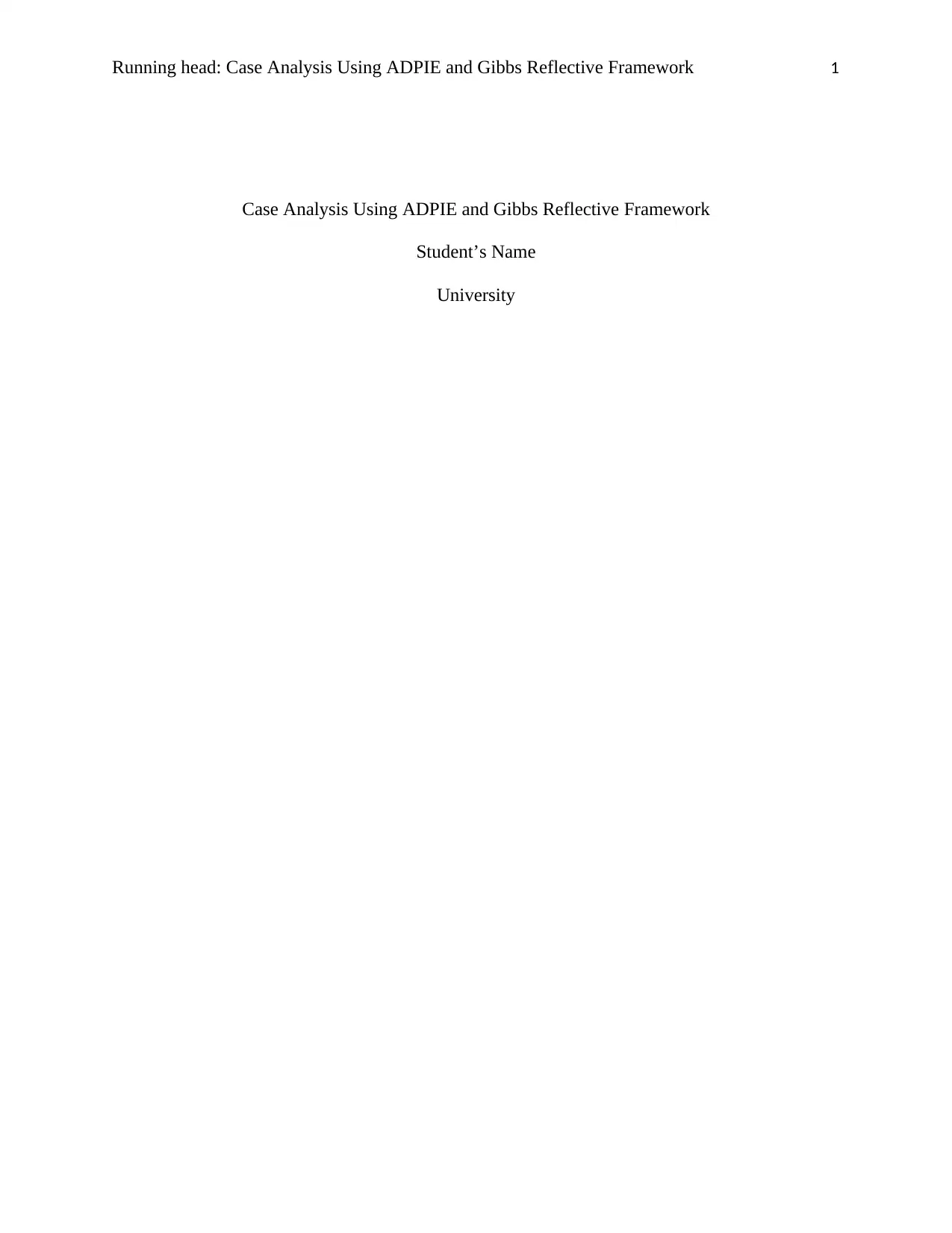
Running head: Case Analysis Using ADPIE and Gibbs Reflective Framework 1
Case Analysis Using ADPIE and Gibbs Reflective Framework
Student’s Name
University
Case Analysis Using ADPIE and Gibbs Reflective Framework
Student’s Name
University
Paraphrase This Document
Need a fresh take? Get an instant paraphrase of this document with our AI Paraphraser
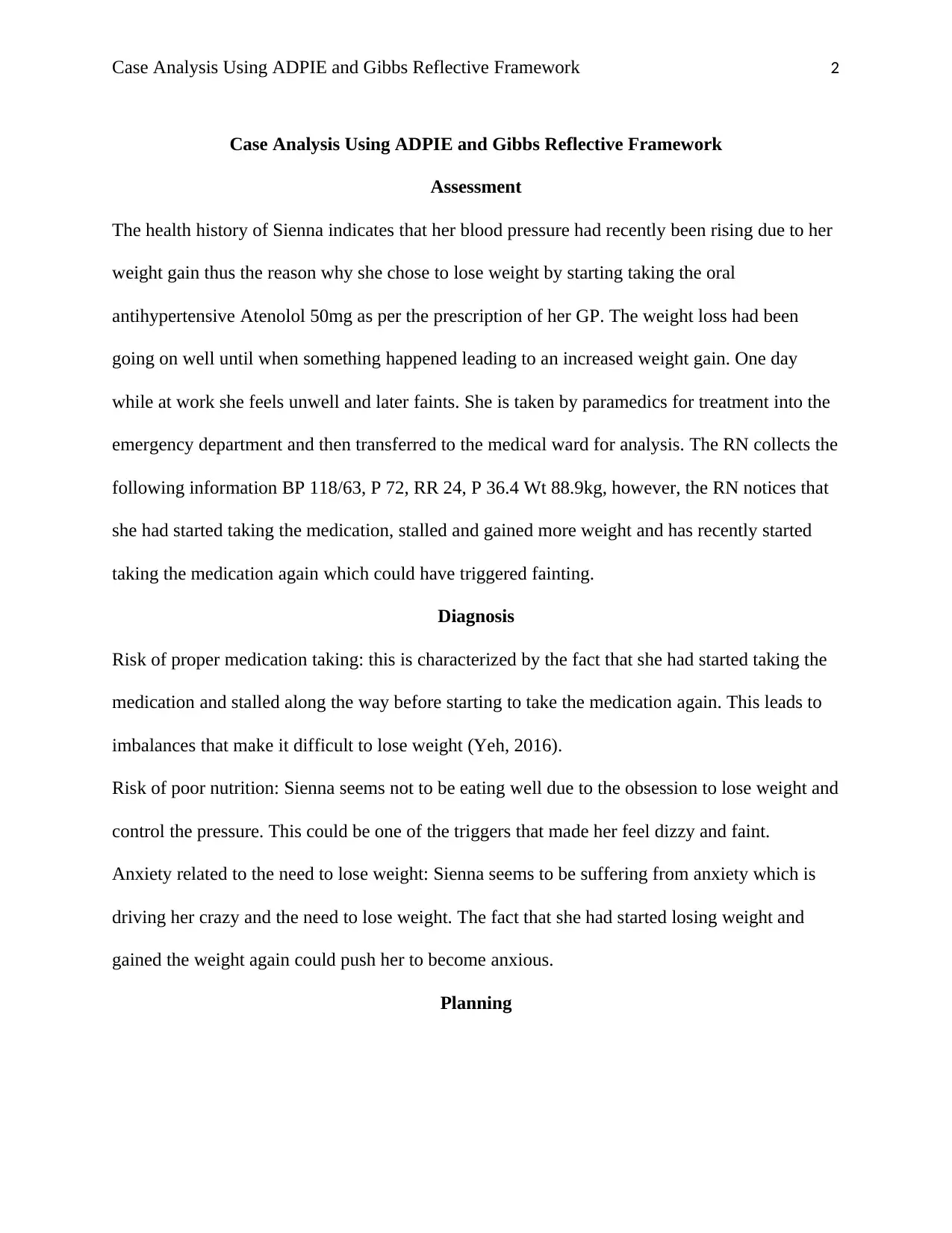
Case Analysis Using ADPIE and Gibbs Reflective Framework 2
Case Analysis Using ADPIE and Gibbs Reflective Framework
Assessment
The health history of Sienna indicates that her blood pressure had recently been rising due to her
weight gain thus the reason why she chose to lose weight by starting taking the oral
antihypertensive Atenolol 50mg as per the prescription of her GP. The weight loss had been
going on well until when something happened leading to an increased weight gain. One day
while at work she feels unwell and later faints. She is taken by paramedics for treatment into the
emergency department and then transferred to the medical ward for analysis. The RN collects the
following information BP 118/63, P 72, RR 24, P 36.4 Wt 88.9kg, however, the RN notices that
she had started taking the medication, stalled and gained more weight and has recently started
taking the medication again which could have triggered fainting.
Diagnosis
Risk of proper medication taking: this is characterized by the fact that she had started taking the
medication and stalled along the way before starting to take the medication again. This leads to
imbalances that make it difficult to lose weight (Yeh, 2016).
Risk of poor nutrition: Sienna seems not to be eating well due to the obsession to lose weight and
control the pressure. This could be one of the triggers that made her feel dizzy and faint.
Anxiety related to the need to lose weight: Sienna seems to be suffering from anxiety which is
driving her crazy and the need to lose weight. The fact that she had started losing weight and
gained the weight again could push her to become anxious.
Planning
Case Analysis Using ADPIE and Gibbs Reflective Framework
Assessment
The health history of Sienna indicates that her blood pressure had recently been rising due to her
weight gain thus the reason why she chose to lose weight by starting taking the oral
antihypertensive Atenolol 50mg as per the prescription of her GP. The weight loss had been
going on well until when something happened leading to an increased weight gain. One day
while at work she feels unwell and later faints. She is taken by paramedics for treatment into the
emergency department and then transferred to the medical ward for analysis. The RN collects the
following information BP 118/63, P 72, RR 24, P 36.4 Wt 88.9kg, however, the RN notices that
she had started taking the medication, stalled and gained more weight and has recently started
taking the medication again which could have triggered fainting.
Diagnosis
Risk of proper medication taking: this is characterized by the fact that she had started taking the
medication and stalled along the way before starting to take the medication again. This leads to
imbalances that make it difficult to lose weight (Yeh, 2016).
Risk of poor nutrition: Sienna seems not to be eating well due to the obsession to lose weight and
control the pressure. This could be one of the triggers that made her feel dizzy and faint.
Anxiety related to the need to lose weight: Sienna seems to be suffering from anxiety which is
driving her crazy and the need to lose weight. The fact that she had started losing weight and
gained the weight again could push her to become anxious.
Planning

Case Analysis Using ADPIE and Gibbs Reflective Framework 3
Put Sienna on a food eating management plan for assisting her control the weight gain. By taking
a proper food portion, she can control weight gain and achieve the desired body weight as
advices by the GP.
Develop a weight loss plan that will entail measuring herself every week to determine the weight
she has lost at the end of the week. This will put her on the right track of weight loss and ensure
that she is able to lose the right amount of weight and determine whether she is gaining or losing
weight at the end of the week (Domecq, et al., 2015).
Offer proper counselling on the challenges of losing weight and the strategies that she can put in
place to address anxiety situations when they arise. Williams, Wood, Collins, & Callister (2015)
suggests that counselling can be sued to increase clinical outcomes by giving moral suport to
patients. This increases their morale and goodwill in clinical processes.
Teach her on management of the oral antihypertensive Atenolol that can arise for the first few
days. Management of the side effects can reduce the risks associated with fainting and improve
her response to such situations when she is alone.
Implementation
Adopt a daily self-monitoring for taking the drug daily to ensure that she does not miss any day.
Maintain a weekly record of weight that she weighs herself.
Maintain a healthy diet through applying the portion of the plate method to control food intake.
Meet with the GP every week to share the challenges and outcomes of weight loss.
Referral to social support groups that are geared towards the weight gain process.
Evaluation
After every visit, Sienna will be assessed to determine the improvements being made in weight
loss. In the visits she will be seen by a dietician to analyze her food intake and offer more
Put Sienna on a food eating management plan for assisting her control the weight gain. By taking
a proper food portion, she can control weight gain and achieve the desired body weight as
advices by the GP.
Develop a weight loss plan that will entail measuring herself every week to determine the weight
she has lost at the end of the week. This will put her on the right track of weight loss and ensure
that she is able to lose the right amount of weight and determine whether she is gaining or losing
weight at the end of the week (Domecq, et al., 2015).
Offer proper counselling on the challenges of losing weight and the strategies that she can put in
place to address anxiety situations when they arise. Williams, Wood, Collins, & Callister (2015)
suggests that counselling can be sued to increase clinical outcomes by giving moral suport to
patients. This increases their morale and goodwill in clinical processes.
Teach her on management of the oral antihypertensive Atenolol that can arise for the first few
days. Management of the side effects can reduce the risks associated with fainting and improve
her response to such situations when she is alone.
Implementation
Adopt a daily self-monitoring for taking the drug daily to ensure that she does not miss any day.
Maintain a weekly record of weight that she weighs herself.
Maintain a healthy diet through applying the portion of the plate method to control food intake.
Meet with the GP every week to share the challenges and outcomes of weight loss.
Referral to social support groups that are geared towards the weight gain process.
Evaluation
After every visit, Sienna will be assessed to determine the improvements being made in weight
loss. In the visits she will be seen by a dietician to analyze her food intake and offer more
⊘ This is a preview!⊘
Do you want full access?
Subscribe today to unlock all pages.

Trusted by 1+ million students worldwide
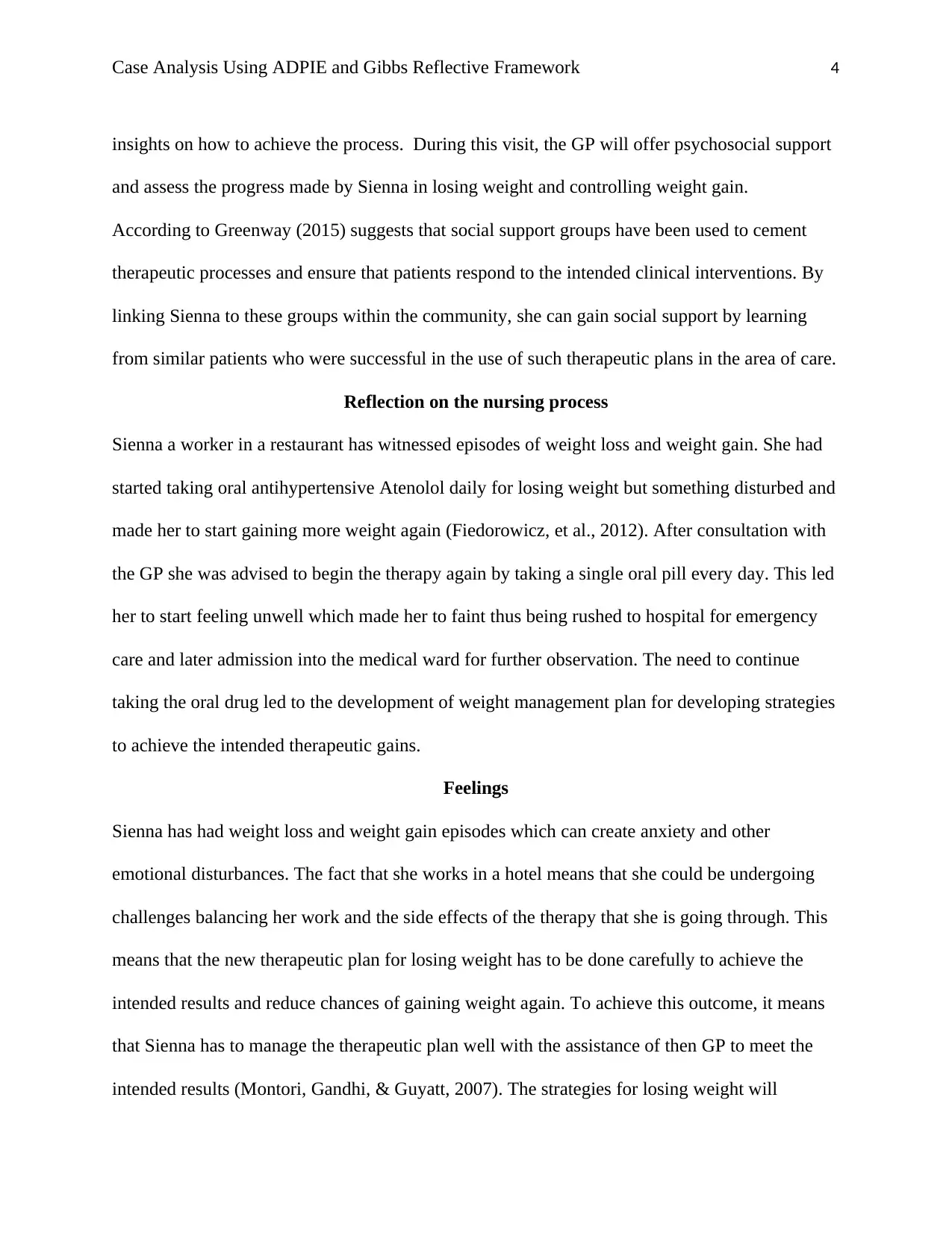
Case Analysis Using ADPIE and Gibbs Reflective Framework 4
insights on how to achieve the process. During this visit, the GP will offer psychosocial support
and assess the progress made by Sienna in losing weight and controlling weight gain.
According to Greenway (2015) suggests that social support groups have been used to cement
therapeutic processes and ensure that patients respond to the intended clinical interventions. By
linking Sienna to these groups within the community, she can gain social support by learning
from similar patients who were successful in the use of such therapeutic plans in the area of care.
Reflection on the nursing process
Sienna a worker in a restaurant has witnessed episodes of weight loss and weight gain. She had
started taking oral antihypertensive Atenolol daily for losing weight but something disturbed and
made her to start gaining more weight again (Fiedorowicz, et al., 2012). After consultation with
the GP she was advised to begin the therapy again by taking a single oral pill every day. This led
her to start feeling unwell which made her to faint thus being rushed to hospital for emergency
care and later admission into the medical ward for further observation. The need to continue
taking the oral drug led to the development of weight management plan for developing strategies
to achieve the intended therapeutic gains.
Feelings
Sienna has had weight loss and weight gain episodes which can create anxiety and other
emotional disturbances. The fact that she works in a hotel means that she could be undergoing
challenges balancing her work and the side effects of the therapy that she is going through. This
means that the new therapeutic plan for losing weight has to be done carefully to achieve the
intended results and reduce chances of gaining weight again. To achieve this outcome, it means
that Sienna has to manage the therapeutic plan well with the assistance of then GP to meet the
intended results (Montori, Gandhi, & Guyatt, 2007). The strategies for losing weight will
insights on how to achieve the process. During this visit, the GP will offer psychosocial support
and assess the progress made by Sienna in losing weight and controlling weight gain.
According to Greenway (2015) suggests that social support groups have been used to cement
therapeutic processes and ensure that patients respond to the intended clinical interventions. By
linking Sienna to these groups within the community, she can gain social support by learning
from similar patients who were successful in the use of such therapeutic plans in the area of care.
Reflection on the nursing process
Sienna a worker in a restaurant has witnessed episodes of weight loss and weight gain. She had
started taking oral antihypertensive Atenolol daily for losing weight but something disturbed and
made her to start gaining more weight again (Fiedorowicz, et al., 2012). After consultation with
the GP she was advised to begin the therapy again by taking a single oral pill every day. This led
her to start feeling unwell which made her to faint thus being rushed to hospital for emergency
care and later admission into the medical ward for further observation. The need to continue
taking the oral drug led to the development of weight management plan for developing strategies
to achieve the intended therapeutic gains.
Feelings
Sienna has had weight loss and weight gain episodes which can create anxiety and other
emotional disturbances. The fact that she works in a hotel means that she could be undergoing
challenges balancing her work and the side effects of the therapy that she is going through. This
means that the new therapeutic plan for losing weight has to be done carefully to achieve the
intended results and reduce chances of gaining weight again. To achieve this outcome, it means
that Sienna has to manage the therapeutic plan well with the assistance of then GP to meet the
intended results (Montori, Gandhi, & Guyatt, 2007). The strategies for losing weight will
Paraphrase This Document
Need a fresh take? Get an instant paraphrase of this document with our AI Paraphraser
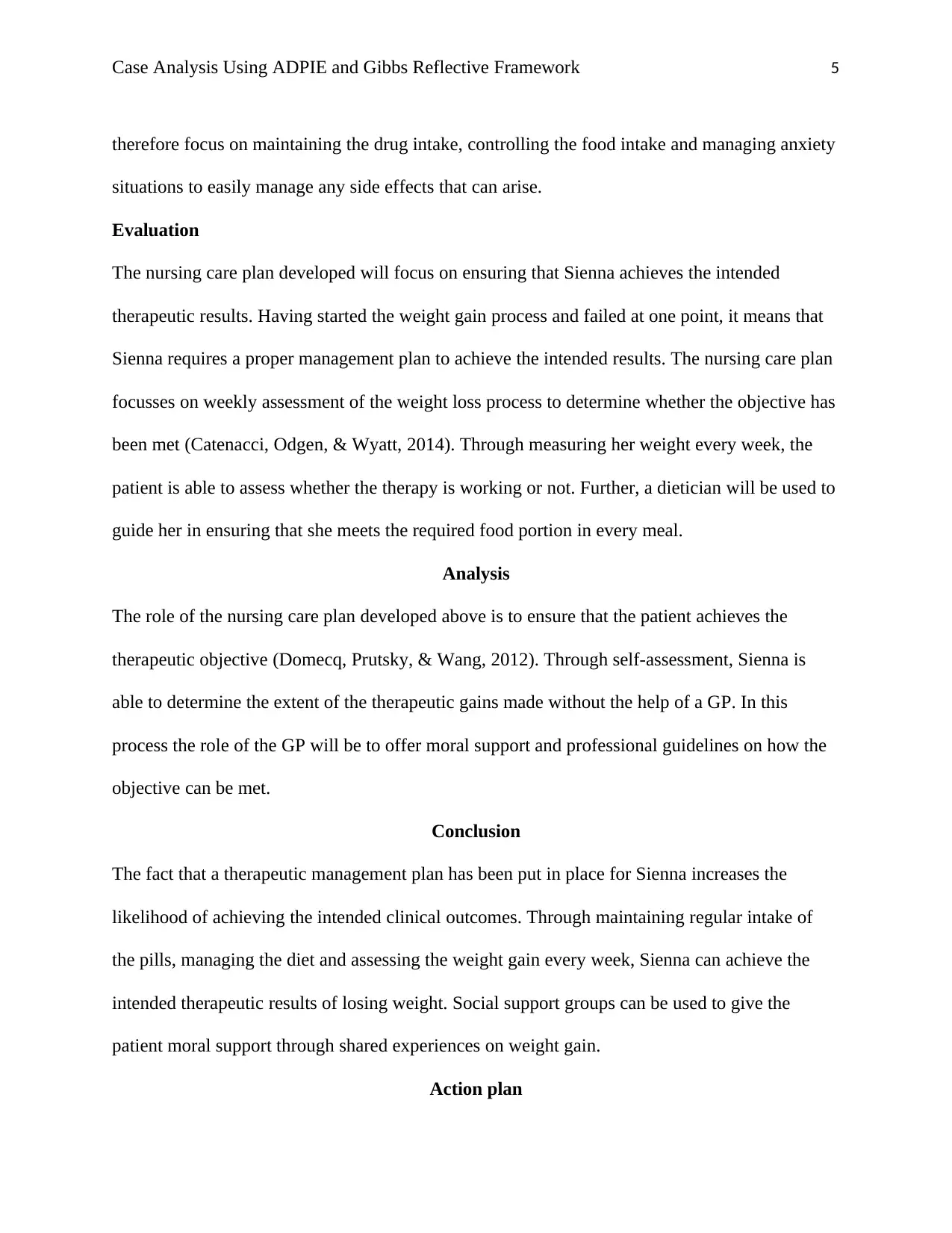
Case Analysis Using ADPIE and Gibbs Reflective Framework 5
therefore focus on maintaining the drug intake, controlling the food intake and managing anxiety
situations to easily manage any side effects that can arise.
Evaluation
The nursing care plan developed will focus on ensuring that Sienna achieves the intended
therapeutic results. Having started the weight gain process and failed at one point, it means that
Sienna requires a proper management plan to achieve the intended results. The nursing care plan
focusses on weekly assessment of the weight loss process to determine whether the objective has
been met (Catenacci, Odgen, & Wyatt, 2014). Through measuring her weight every week, the
patient is able to assess whether the therapy is working or not. Further, a dietician will be used to
guide her in ensuring that she meets the required food portion in every meal.
Analysis
The role of the nursing care plan developed above is to ensure that the patient achieves the
therapeutic objective (Domecq, Prutsky, & Wang, 2012). Through self-assessment, Sienna is
able to determine the extent of the therapeutic gains made without the help of a GP. In this
process the role of the GP will be to offer moral support and professional guidelines on how the
objective can be met.
Conclusion
The fact that a therapeutic management plan has been put in place for Sienna increases the
likelihood of achieving the intended clinical outcomes. Through maintaining regular intake of
the pills, managing the diet and assessing the weight gain every week, Sienna can achieve the
intended therapeutic results of losing weight. Social support groups can be used to give the
patient moral support through shared experiences on weight gain.
Action plan
therefore focus on maintaining the drug intake, controlling the food intake and managing anxiety
situations to easily manage any side effects that can arise.
Evaluation
The nursing care plan developed will focus on ensuring that Sienna achieves the intended
therapeutic results. Having started the weight gain process and failed at one point, it means that
Sienna requires a proper management plan to achieve the intended results. The nursing care plan
focusses on weekly assessment of the weight loss process to determine whether the objective has
been met (Catenacci, Odgen, & Wyatt, 2014). Through measuring her weight every week, the
patient is able to assess whether the therapy is working or not. Further, a dietician will be used to
guide her in ensuring that she meets the required food portion in every meal.
Analysis
The role of the nursing care plan developed above is to ensure that the patient achieves the
therapeutic objective (Domecq, Prutsky, & Wang, 2012). Through self-assessment, Sienna is
able to determine the extent of the therapeutic gains made without the help of a GP. In this
process the role of the GP will be to offer moral support and professional guidelines on how the
objective can be met.
Conclusion
The fact that a therapeutic management plan has been put in place for Sienna increases the
likelihood of achieving the intended clinical outcomes. Through maintaining regular intake of
the pills, managing the diet and assessing the weight gain every week, Sienna can achieve the
intended therapeutic results of losing weight. Social support groups can be used to give the
patient moral support through shared experiences on weight gain.
Action plan

Case Analysis Using ADPIE and Gibbs Reflective Framework 6
Future nursing care plans will focus on tailoring the therapeutic process based on the needs of the
patient. Patients have different healthcare needs and challenges that can inhibit therapeutic
processes or improve the quality of the outcomes. Hall, Hammond, & Rahmandad (2014)
suggests that through tailoring patient care plans with their social and psychological
characteristics, the health practitioner can achieve the intended healthcare outcomes. In
therapeutic plans, patient background plays a role in ensuring shaping the quality of the outcome.
Social determinants of health shape the outcome since they determine the response to the
interventions being made since the influence the clinical processes of the outcome (Dombrowski,
Knittle, Avenell, V., & Sniehotta, 2014). Practitioners have to analyze the patient’s situation and
ensure that strategies developed are done through a participatory approach to increase the
chances of the process being successful.
Future nursing care plans will focus on tailoring the therapeutic process based on the needs of the
patient. Patients have different healthcare needs and challenges that can inhibit therapeutic
processes or improve the quality of the outcomes. Hall, Hammond, & Rahmandad (2014)
suggests that through tailoring patient care plans with their social and psychological
characteristics, the health practitioner can achieve the intended healthcare outcomes. In
therapeutic plans, patient background plays a role in ensuring shaping the quality of the outcome.
Social determinants of health shape the outcome since they determine the response to the
interventions being made since the influence the clinical processes of the outcome (Dombrowski,
Knittle, Avenell, V., & Sniehotta, 2014). Practitioners have to analyze the patient’s situation and
ensure that strategies developed are done through a participatory approach to increase the
chances of the process being successful.
⊘ This is a preview!⊘
Do you want full access?
Subscribe today to unlock all pages.

Trusted by 1+ million students worldwide
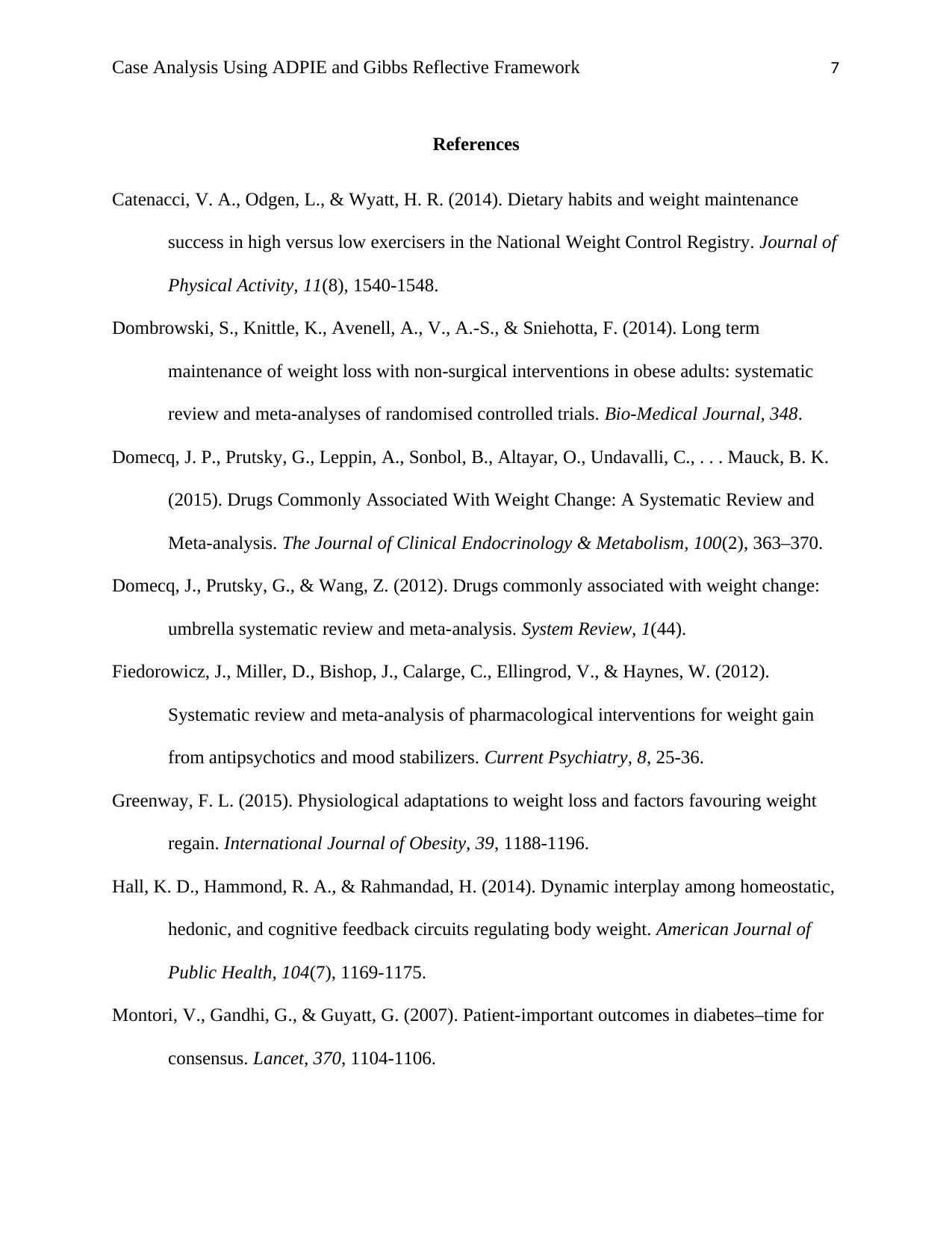
Case Analysis Using ADPIE and Gibbs Reflective Framework 7
References
Catenacci, V. A., Odgen, L., & Wyatt, H. R. (2014). Dietary habits and weight maintenance
success in high versus low exercisers in the National Weight Control Registry. Journal of
Physical Activity, 11(8), 1540-1548.
Dombrowski, S., Knittle, K., Avenell, A., V., A.-S., & Sniehotta, F. (2014). Long term
maintenance of weight loss with non-surgical interventions in obese adults: systematic
review and meta-analyses of randomised controlled trials. Bio-Medical Journal, 348.
Domecq, J. P., Prutsky, G., Leppin, A., Sonbol, B., Altayar, O., Undavalli, C., . . . Mauck, B. K.
(2015). Drugs Commonly Associated With Weight Change: A Systematic Review and
Meta-analysis. The Journal of Clinical Endocrinology & Metabolism, 100(2), 363–370.
Domecq, J., Prutsky, G., & Wang, Z. (2012). Drugs commonly associated with weight change:
umbrella systematic review and meta-analysis. System Review, 1(44).
Fiedorowicz, J., Miller, D., Bishop, J., Calarge, C., Ellingrod, V., & Haynes, W. (2012).
Systematic review and meta-analysis of pharmacological interventions for weight gain
from antipsychotics and mood stabilizers. Current Psychiatry, 8, 25-36.
Greenway, F. L. (2015). Physiological adaptations to weight loss and factors favouring weight
regain. International Journal of Obesity, 39, 1188-1196.
Hall, K. D., Hammond, R. A., & Rahmandad, H. (2014). Dynamic interplay among homeostatic,
hedonic, and cognitive feedback circuits regulating body weight. American Journal of
Public Health, 104(7), 1169-1175.
Montori, V., Gandhi, G., & Guyatt, G. (2007). Patient-important outcomes in diabetes–time for
consensus. Lancet, 370, 1104-1106.
References
Catenacci, V. A., Odgen, L., & Wyatt, H. R. (2014). Dietary habits and weight maintenance
success in high versus low exercisers in the National Weight Control Registry. Journal of
Physical Activity, 11(8), 1540-1548.
Dombrowski, S., Knittle, K., Avenell, A., V., A.-S., & Sniehotta, F. (2014). Long term
maintenance of weight loss with non-surgical interventions in obese adults: systematic
review and meta-analyses of randomised controlled trials. Bio-Medical Journal, 348.
Domecq, J. P., Prutsky, G., Leppin, A., Sonbol, B., Altayar, O., Undavalli, C., . . . Mauck, B. K.
(2015). Drugs Commonly Associated With Weight Change: A Systematic Review and
Meta-analysis. The Journal of Clinical Endocrinology & Metabolism, 100(2), 363–370.
Domecq, J., Prutsky, G., & Wang, Z. (2012). Drugs commonly associated with weight change:
umbrella systematic review and meta-analysis. System Review, 1(44).
Fiedorowicz, J., Miller, D., Bishop, J., Calarge, C., Ellingrod, V., & Haynes, W. (2012).
Systematic review and meta-analysis of pharmacological interventions for weight gain
from antipsychotics and mood stabilizers. Current Psychiatry, 8, 25-36.
Greenway, F. L. (2015). Physiological adaptations to weight loss and factors favouring weight
regain. International Journal of Obesity, 39, 1188-1196.
Hall, K. D., Hammond, R. A., & Rahmandad, H. (2014). Dynamic interplay among homeostatic,
hedonic, and cognitive feedback circuits regulating body weight. American Journal of
Public Health, 104(7), 1169-1175.
Montori, V., Gandhi, G., & Guyatt, G. (2007). Patient-important outcomes in diabetes–time for
consensus. Lancet, 370, 1104-1106.
Paraphrase This Document
Need a fresh take? Get an instant paraphrase of this document with our AI Paraphraser
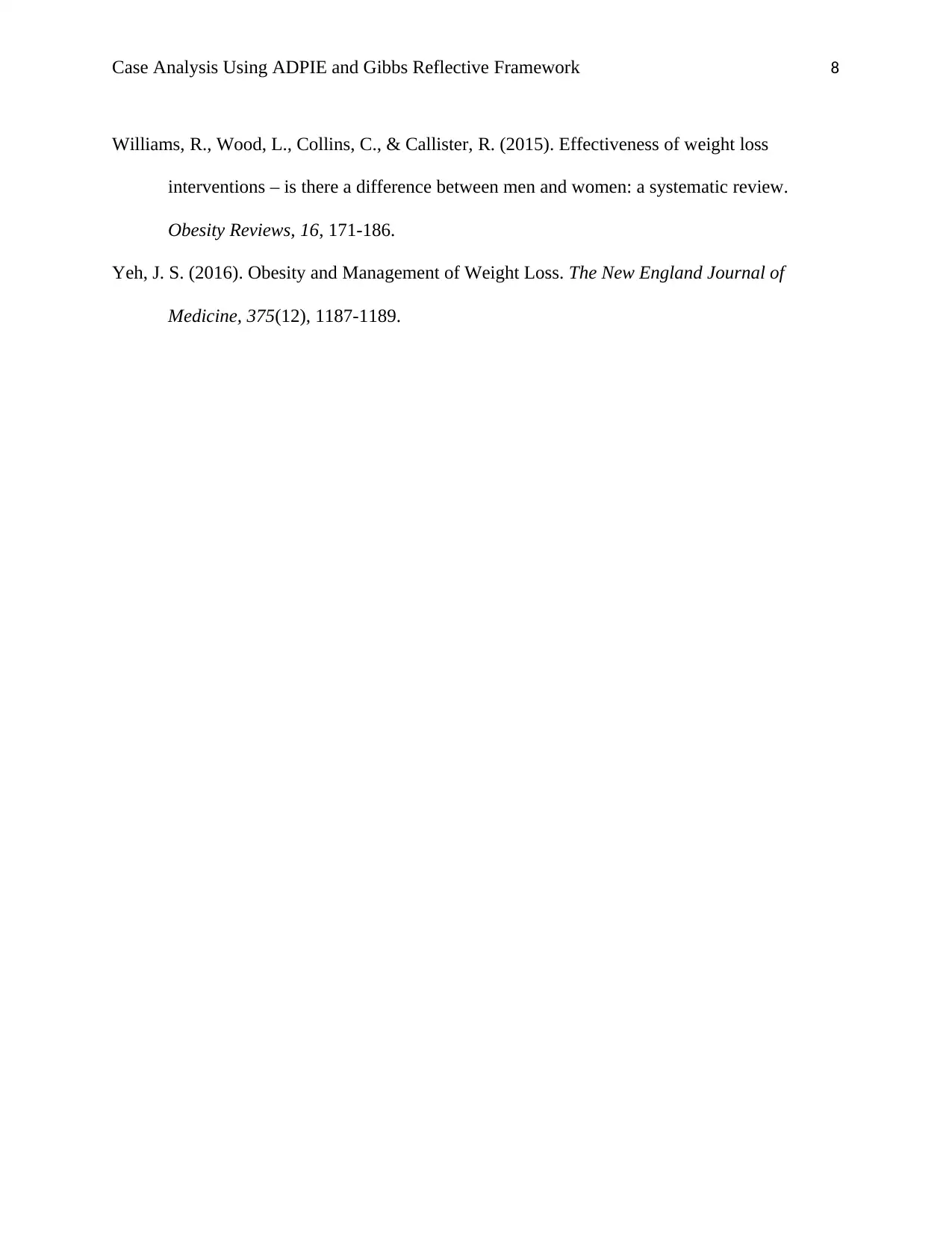
Case Analysis Using ADPIE and Gibbs Reflective Framework 8
Williams, R., Wood, L., Collins, C., & Callister, R. (2015). Effectiveness of weight loss
interventions – is there a difference between men and women: a systematic review.
Obesity Reviews, 16, 171-186.
Yeh, J. S. (2016). Obesity and Management of Weight Loss. The New England Journal of
Medicine, 375(12), 1187-1189.
Williams, R., Wood, L., Collins, C., & Callister, R. (2015). Effectiveness of weight loss
interventions – is there a difference between men and women: a systematic review.
Obesity Reviews, 16, 171-186.
Yeh, J. S. (2016). Obesity and Management of Weight Loss. The New England Journal of
Medicine, 375(12), 1187-1189.
1 out of 8
Your All-in-One AI-Powered Toolkit for Academic Success.
+13062052269
info@desklib.com
Available 24*7 on WhatsApp / Email
![[object Object]](/_next/static/media/star-bottom.7253800d.svg)
Unlock your academic potential
Copyright © 2020–2025 A2Z Services. All Rights Reserved. Developed and managed by ZUCOL.